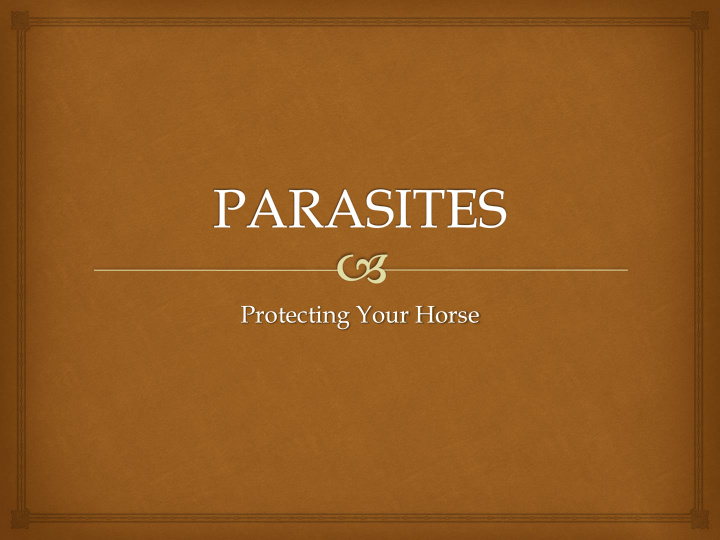



Protecting Your Horse
Review – The Drugs Fenbendazole SafeGuard, Panacur Treatment of choice for Parascaris equorum (ascarids) in young animals Ivermectin / Moxidectin Eqvalan, Panomec, Bimectin, Equimax / Quest Treatment of choice for small and large strongyles Also treats for bots, external parasites (lice, mites) and summer sores (habronema, drashcia) Moxidectin is labeled for encysted larva Praziquantel Quest Plus, Eqvalan Gold, Equimax (come as a combination with ivermectin or moxidectin) Treatment for tapeworms
Out with the old… Why do we need to leave rotational deworming behind? 1. Growing resistance of parasites to available dewormers 2. Change in parasitic fauna 3. Improved understanding of individual susceptibility
…in with the new! Selective deworming How to design a parasite programs for the modern horse? No “one size fits all” programs – need to tailor to specific needs of each farm New monitoring techniques FEC (fecal egg count) identify which horses need to be dewormed FECRT (fecal egg count reduction test) monitor for the presence of resistance ERP (egg reappearance period) Monitor for the development of resistance
The FEC Why? Identify which horses need to be dewormed What? A quantitative evaluation by centrifugation is needed for equine fecal egg counts. Be informed about the type of test being performed to ensure accuracy of results When? All horses should be done at least once yearly in July/August New horses should be done on arrival High shedders or horses of unclear shedding status should be done spring, summer and fall to test before deworming How? Sample must be fresh (still steaming is best!) Collect a small handful of fecal material in a small ziplock bag and seal tightly. Refrigerate immediately upon collect and keep refrigerated until brought to the clinic for analysis
Adult Horses 1-2 yearly treatments (spring and late fall) for all horses For control of large strongyles, tapeworms, bots and summer sores (Habronema) Fall deworming should contain praziquantel to cover for tapeworms and should be done after the first good frost Targeted treatment for high shedding horses For small strongyles FEC – identify and treat only high shedding horses
Young Horses Targeted treatment not appropriate. These horse require frequent deworming. Dose appropriately – need to get an accurate weight and provide appropriate amount of dewormer Under-dosing can result in failure to reduce parasitic infection and promotes development of resistance
Young Horses Deworming protocol 2-3 months old Target: ascarids Drug: fenbendazole 5-6 months old Target: Ascarids Drug: Fenbendazole Around 6 months old FEC – need to assess ascarid versus strongyle load to determine which dewormers to use next 9 months Target: Strongyles OR Ascarids Drug: Ivermectin/Moxidectin OR fenbendazole 12 months Target: Strongyles, tapeworms Drug: Ivermectin/Moxidectin and praziquantel Yearlings and 2 – Year olds Deworm 3-4 times through the year Use FEC to determine ascarid versus strongyle burden for appropriate drug selection
Additional methods of control Pasture management Stocking density Regular removal of feces from pens/pasture Pasture rotation Manure composting Note about harrowing Stall management Important for foals!
Recommend
More recommend